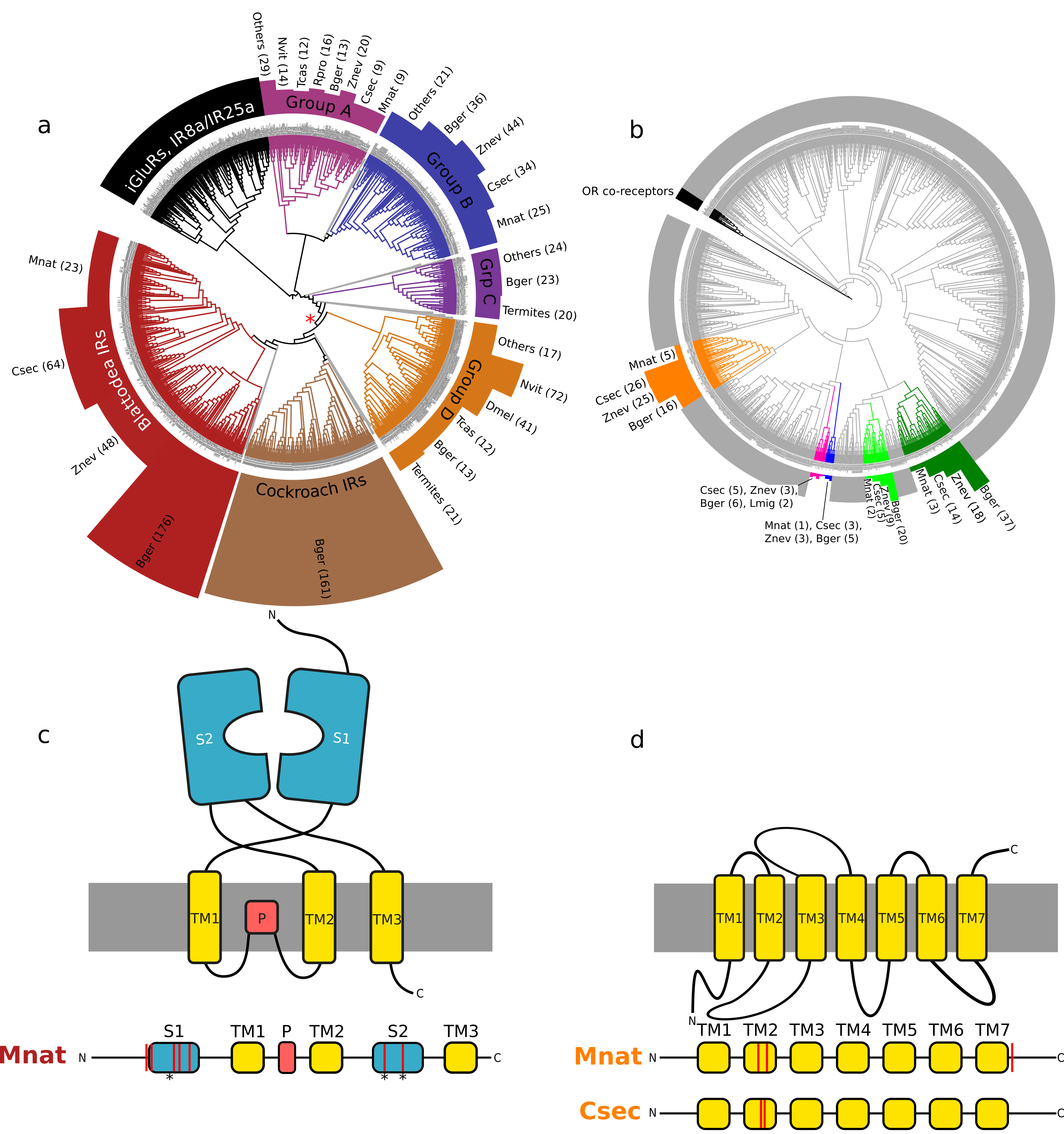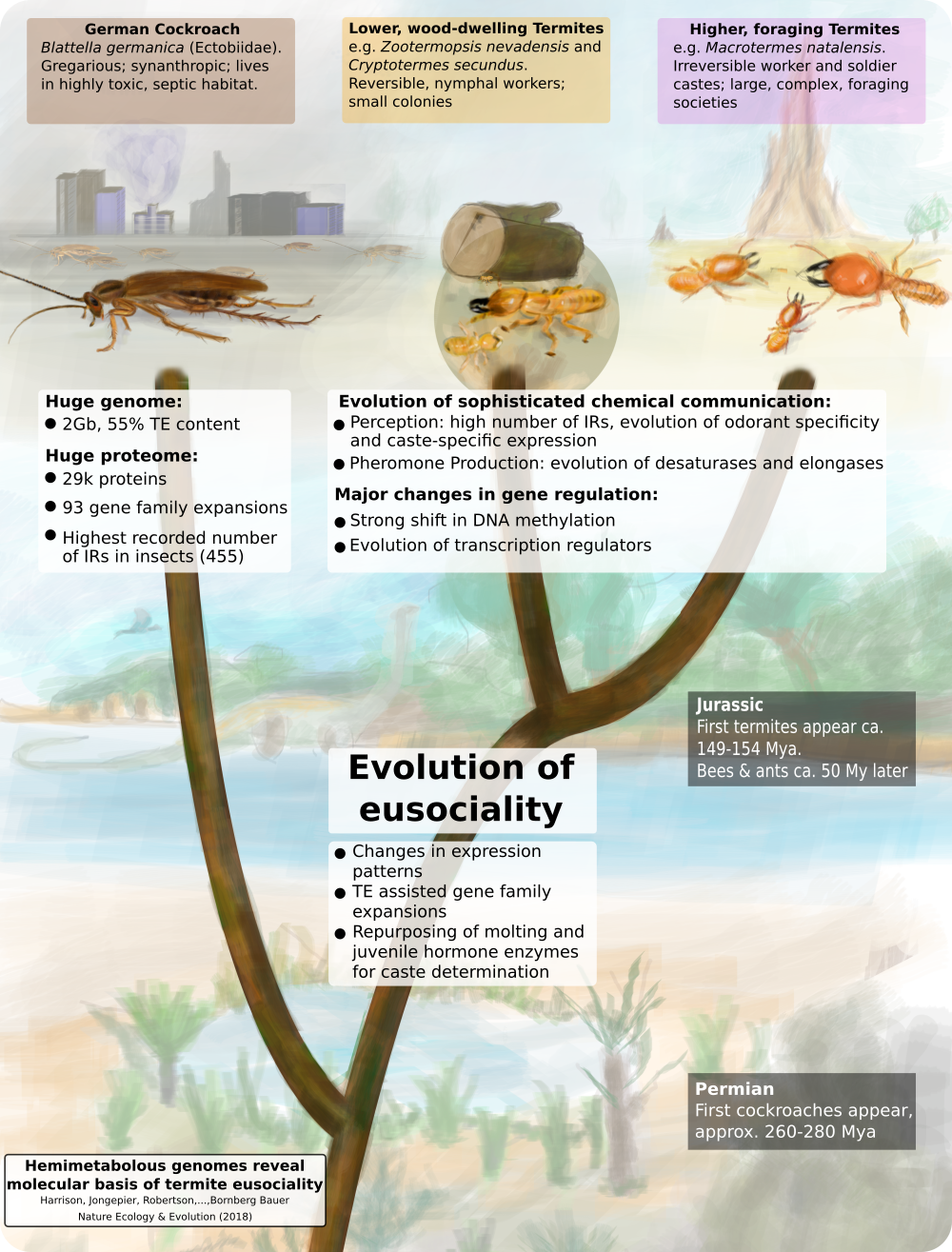G1: Comparative Genomics and Molecular Mechanisms Underlying the Evolution of Complex Traits in Insects
Sociality is considered to be one of the major transitions in evolution but only little of the underlying genomic basis and the associated selectable
traits are known. Social insects are an excellent study object because their genomes are relatively simple to analyse and many speciation events gave rise
to morphologically and ecologically diverse species within a relatively short time period. Furthermore, in insects, sociality has independently evolved
at least twice, in Hymenoptera (comprising ants and bees) and in termites. Both groups also show a striking reversal of the otherwise widely spread
trade-off between longevity and fecundity. Furthermore, loss and/or reversal of social behaviour has been observed since several ants parasitise or enslave
the colonies of very closely related species.
We have investigated genomes and transcriptomes of several insects, most of which are either social or closely related outgroups thereof. Using standard
bioinformatic techniques and several of our in-house algorithms we could identify horizontally transfered genes from bacterial parasites, several genes
under adaptation and novel genes which were instrumental for the ecological success of social insects. In comparing social with non-social insects, we
found that novel genes and the rewiring of regulatory networks both play a big role for the regulation of sociality. We also consider the epigenetic marks
and effects from methylation/acetylation and of small regulatory RNAs on the differentiation of individuals during their development to test the possible
role of epigenetic marks in general and their effect on de novo genes and on rearranged genes. Finally, using comparative genomics between closely related
host/parasite pairs across multiple origins of social parasitism in ants, we investigated gene family dynamics underlying the transition to a parasitic lifestyle.
People: Mark Harrison, Alice Séguret, Elias Dohmen, Bertrand Fouks, Alina Mikhailova, Alun Jones

Collaborations
- Judith Korb (Freiburg)
- Thomas Flatt (Lausanne)
- Jürgen Heinze (Regensburg)
- Susanne Foitzik (Mainz)
- Bernhard Misof (Bonn)
- Joshua Benoit (Cincinnati)
- Elisabeth Marchal (Leuven)
- Stephen Tobe (Toronto)
- Dino McMahon (Berlin)
- Barbara Feldmeyer (Frankfurt)
- Mireille Vasseur-Cognet (Paris)
- Frédéric Legendre (Paris)
Funding: DFG (2015 - 2019, 2017 - 2022); HFSP (2018-2021); ANR/DFG (2020-2023); MSCA-IF (2021-2023)

Related Publications
- He S, Sieksmeyer T, Che Y, Esparza Mora MA, Stiblik P, Banasiak R, Harrison MC, Sobotnik J, Wang Z, Johnston PR, McMahon DP. Evidence for reduced immune gene diversity and activity during the evolution of termites. Proceedings of the Royal Society B 2021. Online Access
- Harrison MC, Chrenyshova AM, Thompson GJ. No obvious transcriptome-wide signature of indirect selection in termites. Journal of Evolutionary Biology 2020. Online Access
- Thomas GWC et al. Gene content evolution in the arthropods. Genome Biology 2020. Online Access
- Gstöttl C, Stoldt M, Jongepier E, Bornberg-Bauer E, Feldmeyer B, Heinze J, Foitzik S. Comparative analyses of caste, sex and developmental stage-specific transcriptomes in two Temnothorax ants. Ecology & Evolution 2020.
- Harrison MC et al. Hemimetabolous genomes reveal molecular basis of termite eusociality. Nature Ecology & Evolution 2018. Online Access
- Jongepier E, Kemena C, Lopez-Ezquerra A, Belles X, Bornberg-Bauer E, Korb J. Remodeling of the juvenile hormone pathway through caste‐biased gene expression and positive selection along a gradient of termite eusociality. Journal of Experimental Zoology Part B 2018. Online Access
- Kremer LPM, Korb J, Bornberg-Bauer E. Reconstructed evolution of insulin receptors in insects reveals duplications in early insects and cockroaches. Journal of Experimental Zoology Part B 2018. Online Access
- Smith CR, Helms Cahan S, Kemena C, Brady SG, Yang W, Bornberg-Bauer E, Eriksson T, Gadau J, Helmkampf M, Gotzek D, Miyakawa MO, Suarez AV, Mikheyev A. How do genomes create novel phenotypes? Insights from the loss of the worker caste in ant social parasites. Molecular Biology & Evolution 2015. Online Access
- Sadd B et al. The genomes of two key bumblebee species with primitive eusocial organization. Genome Biology 2015. Online Access
- Terrapon N et al. Molecular traces of alternative social organization in a termite genome. Nat Communications 2014. Online Access
- Simola DF et al. Social insect genomes exhibit dramatic evolution in gene composition and regulation while preserving regulatory features linked to sociality. Genome Research 2013. Online Access
- Niehuis O et al. Genomic and morphological evidence converge to resolve the enigma of Strepsiptera. Current Biology 2012. Online Access
- Sueng G et al. The genome sequence of the leaf-cutter ant Atta cephalotes reveals insights into its obligate symbiotic lifestyle. PLoS Genetics 2012. Online Access
- Werren JH et al. Functional and evolutionary insights from the genomes of three parasitoid Nasonia species. Science 2010. Online Access
- Olsen J et al. The genome of the seagrass Zostera marina reveals angiosperm adaptation to the sea. Nature 2016. Online Access
- Myburg Z et al. The genome of Eucalyptus grandis. Nature 2014. Online Access
Techniques employed: cuffsuite; 454, Illumina, PacBio, ONP; AllPath, SoapDeNovo, MIRA, Platanus, Spades,
MaSuRCA; Maker; BUSCO, DOGMA; PorthoDOM, proteinOrtho; RaXML, CodeML/PAML and many others.
